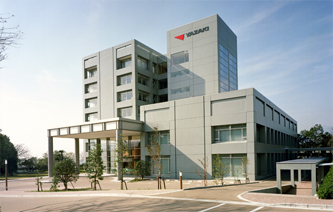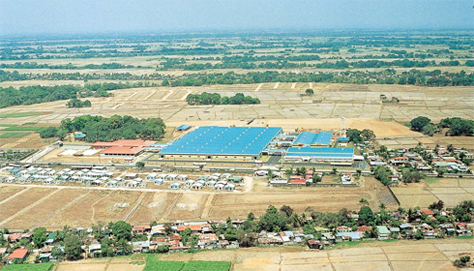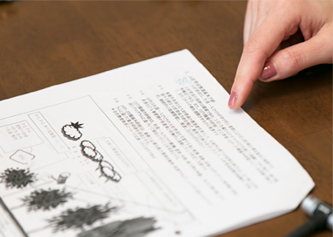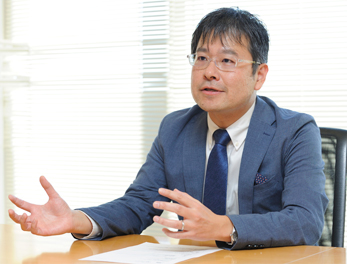Yazaki Corporation "Yazaki's Approach to Developing Global leaders - A Case Study in Valuing Employees"
Yazaki Corporation Profile
・Founded: October 8, 1941
・Head Office: 17F Mita Kokusai Bldg. 1-4-28 Mita,
Minato-ku, Tokyo, 108-8333
・Head Office: 17F Mita Kokusai Bldg. 1-4-28 Mita,
Minato-ku, Tokyo, 108-8333

Representative Director and President, Mr. Shinji Yazaki
・Capital: 3.1915 billion yen
・Business Activities: Development; manufacture and sale of automotive instruments,
wire harnesses and other products
・No. of employees: Japan: 20,195; Overseas: 265,605; Total: 285,800
(Including unconsolidated subsidiaries and affiliates)
*Accurate as of June 20, 2017

Y-CITY World Headquarters (Hereafter, WHQ)
Interview
Human Resources Development Department
General Affairs and Personnel Division
A Common “Belief” that Ties the Company’s Past with the Present Day, and Japan with the World
For example, Yazaki has a culture of providing any employee with the opportunity to learn something new when they have a desire to do so. This belief stems from the company’s founder, Mr. Sadami Yazaki.Mr. Sadami Yazaki and his family lived in extreme poverty throughout his childhood.While having a love for studying, Mr. Sadami Yazaki abandoned on his dream of pursuing further studies to become an apprentice at the age of 15.The desire to study never left him however, even after joining the work force.
This passion for study still seeps through the company even today.For example, employees with the desire to study overseas for an MBA will have the full support of the company behind them, including assistance in covering the required tuition fees and rent.
“What’s the point?”, “That’s a waste of money.” A new human resource development proposal raised by the HRD is not going to be met with such flat condemnation. Even if the effectiveness of such measures and other details come under the microscope, this is intended at pushing the plan forward towards its eventual implementation. There is a real sense that the belief of the company’s founder in “valuing employee growth” and “supporting further learning” has firmly taken root within the company’s culture.
One can get a sense of this steadfast belief being spread not only within the Japanese headquarters, but worldwide as well.The HRD team is currently implementing training at subsidiaries across Asia with a focus on ingraining a sense of the Yazaki Group management philosophy.
Yazaki Group Corporate Policy
“A Corporation in Step with the World” “A Corporation Needed by Society”
Yazaki Spirit
“Fortitude” “Service Mind” “Foresight”
Let me give an example of a training session held at a local subsidiary in the Philippines.
As the objective of this training was ingraining a better sense of the company’s management philosophy, naturally the philosophy first needed explaining.However, imparting a true understanding of the corporate policy and the Yazaki spirit to local employees is not an easy task.The training covered the trials and tribulations of Mr. Sadami Yazaki as he founded the company and started the business, as well as his thoughts on global expansion.
During the training we played a DVD that was made in commemoration of the Company's 75th anniversary.The DVD posed the question - “What is your connection?” - to which employees from all over the world answered one by one.When a pregnant Vietnamese woman made an appearance at the end of the DVD I started to hear sobbing in the audience.The Vietnamese woman on the DVD told us in the audience that “Yazaki connected me with my unborn child”.
There is a factory in the Philippines called EDS Manufacturing Inc. (hereafter, EMI) that is established on a site that was once considered extremely dangerous some 30 years ago. This was a place that even locals dared not venture towards, where murders and other heinous crimes were a common occurrence.However, the establishment of this factory brought with it new roads, housing and other infrastructure development, turning this area into somewhere that people did not fear to tread.The message from this Vietnamese woman really seemed to strike a chord with the Filipino employees.
The Filipino employees all hold a deep affection for the former site manager who was responsible for establishing the site in the Philippines.
“He was a very strict site manager, but gave us all chocolate when we achieved good results. This was the best tasting chocolate I have ever had in my life,” said an employee.Another employee recited “that boughs that bear most hang lowest” - an expression picked up from a Japanese employee on transfer at the time.
As the objective of this training was ingraining a better sense of the company’s management philosophy, naturally the philosophy first needed explaining.However, imparting a true understanding of the corporate policy and the Yazaki spirit to local employees is not an easy task.The training covered the trials and tribulations of Mr. Sadami Yazaki as he founded the company and started the business, as well as his thoughts on global expansion.
During the training we played a DVD that was made in commemoration of the Company's 75th anniversary.The DVD posed the question - “What is your connection?” - to which employees from all over the world answered one by one.When a pregnant Vietnamese woman made an appearance at the end of the DVD I started to hear sobbing in the audience.The Vietnamese woman on the DVD told us in the audience that “Yazaki connected me with my unborn child”.
There is a factory in the Philippines called EDS Manufacturing Inc. (hereafter, EMI) that is established on a site that was once considered extremely dangerous some 30 years ago. This was a place that even locals dared not venture towards, where murders and other heinous crimes were a common occurrence.However, the establishment of this factory brought with it new roads, housing and other infrastructure development, turning this area into somewhere that people did not fear to tread.The message from this Vietnamese woman really seemed to strike a chord with the Filipino employees.
The Filipino employees all hold a deep affection for the former site manager who was responsible for establishing the site in the Philippines.
“He was a very strict site manager, but gave us all chocolate when we achieved good results. This was the best tasting chocolate I have ever had in my life,” said an employee.Another employee recited “that boughs that bear most hang lowest” - an expression picked up from a Japanese employee on transfer at the time.

EMI in the Philippines
When approaching this training, we believe that the manner in which philosophy such as our corporate policy and Yazaki spirit is interpreted, and how these are positioned within our business activities, will vary from country to country based on the country’s social and religious beliefs, and on the level of organizational development and maturity.
Even if we fail to clearly define this outlook, I believe that the long-held connection we have with employees at local subsidiaries helped us impart a deeper understanding of the Yazaki credo.
The Filipino employees that spoke with us were in their mid to late 50s, and had been with the plant since its establishment.
I feel that the main challenge ahead, both for them and our team, lies in the manner in which they can pass on what they have learned and experienced to the next generation when they leave Yazaki in five to ten years’ time.
Even if we fail to clearly define this outlook, I believe that the long-held connection we have with employees at local subsidiaries helped us impart a deeper understanding of the Yazaki credo.
The Filipino employees that spoke with us were in their mid to late 50s, and had been with the plant since its establishment.
I feel that the main challenge ahead, both for them and our team, lies in the manner in which they can pass on what they have learned and experienced to the next generation when they leave Yazaki in five to ten years’ time.
Training Derived from a Belief that One’s Nationality is Irrelevant
This challenge often rears its head when visiting local subsidiaries.
Therefore, In 2013, when considering future global human resource policies, we set about quantitatively analyzing the number of people transferred to each local subsidiaries, the number of transfers made, the number of years per transfer period, the average age of transferees, as well as trends in the number of transferees over the past 10 years and the ratio of local to Japanese employees at each subsidiary in an attempt to expose issues that needed addressing.
This study brought many issues to light.One issue that the Human Resources Development Department found particularly notable was the ratio of Japanese to local employees in management.
Employee localization at overseas sites comes with its own advantages and disadvantages.The challenges presented to management vary from country and region, and certain positions are more suited to Japanese managers.Conversely, it seemed to me that one’s nationality mattered little provided that the person had a firm understanding of the company, which is what led me to propose an Asian site manager training program.
Therefore, In 2013, when considering future global human resource policies, we set about quantitatively analyzing the number of people transferred to each local subsidiaries, the number of transfers made, the number of years per transfer period, the average age of transferees, as well as trends in the number of transferees over the past 10 years and the ratio of local to Japanese employees at each subsidiary in an attempt to expose issues that needed addressing.
This study brought many issues to light.One issue that the Human Resources Development Department found particularly notable was the ratio of Japanese to local employees in management.
Employee localization at overseas sites comes with its own advantages and disadvantages.The challenges presented to management vary from country and region, and certain positions are more suited to Japanese managers.Conversely, it seemed to me that one’s nationality mattered little provided that the person had a firm understanding of the company, which is what led me to propose an Asian site manager training program.
Sanno University was involved from the planning stage, providing invaluable support for holding the Asian site manager training program.
“Standardizing site manager knowledge” was brought to the fore as the most pressing issue covered in repeated discussions on the matter.
Position requirements for the plant manager and president at overseas sites are not necessarily consistent with equivalent positions in Japan within our human resource management system.For this reason, while transfer employees receiving the necessary training in business management under the new human resource management system introduced in 2014 posed no problem, it became apparent that there were real issues with groups of employees that were transferred out with insufficient knowledge and skills outside of one’s field of specialty having not had the opportunity to receive the training.
For example, while an employee in a production department may be an expert in terms of production, they do not necessarily have the sufficient knowledge and skills as a manager to be able to effectively allocate management resource and develop business strategies.
We aimed to leverage this training to cover for areas in which such transfer employees were lacking while maintaining a solid grasp on their specific needs in light of these circumstances.
“Asian Site Manager Training” that takes into Account the Opinions of Local Employees
In light of the importance of human resource development in promoting the further assignment of local employees in important roles, the first event focused on “human resource management”.This program had participants think on the type of human resource management required to produce results while maintaining a solid grasp on the entire human resource development process - from hiring to resignation - including employee hiring, training, placement, and performance evaluation.
The second and subsequent programs are based around issues and concerns confronting individual site managers based on survey responses received from attendees.As a result, participants were able to gain a better understanding of the “financial knowledge required to put strategies into action” - an area of particular interest to many attendees.Following an inspection tour of Vietnam conducted in February 2017 with Mr. Matsuo, a researcher at Sanno University responsible for implementing the training, we set “management accounting for local subsidiaries” as the theme for the third event in consideration of the current circumstances and future issues.
In reality this training program presents its own problems in that the program needs to be reworked to cater to a different set of attendees every time transfer employees are replaced.For example, an employee not present at the first and second training sessions may be required to attend the third session as a new site manager,While we currently support the employees by giving them related information and assignments beforehand, in the future we will look to shift to providing training on the knowledge and skills needed as site managers before transferring out, not after.

The preparation time available from when someone is selected as a site manager to when they transfer out is extremely short, and I feel the system used to select site managers needs to undergo further review.
As the Human Resources Development Department, we hope to prioritize a deeper involvement with each participant in the training that goes beyond that of simply acting as a training administrator, one that better takes into account the concerns and needs of trainees regarding the training.
Preparing a Generation of Leaders for Tomorrow
This event not only provides the children with an opportunity for new discoveries and experiences, but also helps foster an appreciation for the environment and instills in them a deeper mutual understanding of other cultures through international exchanges.This summer camp has now continued for 40 years, and is attended by a total of over 15,000 camp participants both in Japan and abroad.
Now in its 23rd year, the “Yazaki Corporate Culture Training” is a human resource development program that sends employees from overseas Group companies to Japan to promote an understanding of the corporate culture at Yazaki while also teaching them about the Japanese language and culture.Over 200 employees have completed this training program.
Participants in this program immerse themselves in the local environment during their year-long stay in Japan, before going on to act as a pipeline bridging the gap between Japan and their own country upon their return.
Looking ahead, we hope to promote further avenues for human resource development through these activities in an aim to become a truly global company in the future.
Message from Mr. Matsuo, a researcher at Sanno University
While most people there exhibited the utmost professionalism towards production management and work improvements, I feel the training made many aware of the need for improvements through partial optimization measures introduced from an overall optimization perspective based on what they learned on the human resource management and financial strategies required for management.
I myself learned a great deal from the discussions on how to go about establishing each strategic method based on the challenges inherent in overseas business operations.
I was also particularly struck by how many site managers spoke with passion about the company’s management philosophy.Seeing the Yazaki spirit expressed in their own words was a particularly eye-opening experience for me. The management philosophy is clearly firmly rooted in the foundations of success exhibited by overseas business arms.With many companies focusing on language training and other technical skills as a means of finding success overseas, this training reminded me just how important it is to ingrain a sense of the management philosophy of a company.
I was also particularly struck by how many site managers spoke with passion about the company’s management philosophy.Seeing the Yazaki spirit expressed in their own words was a particularly eye-opening experience for me. The management philosophy is clearly firmly rooted in the foundations of success exhibited by overseas business arms.With many companies focusing on language training and other technical skills as a means of finding success overseas, this training reminded me just how important it is to ingrain a sense of the management philosophy of a company.

Hiroshi Matsuo
Senior Researcher
Management Training and Consulting Division
